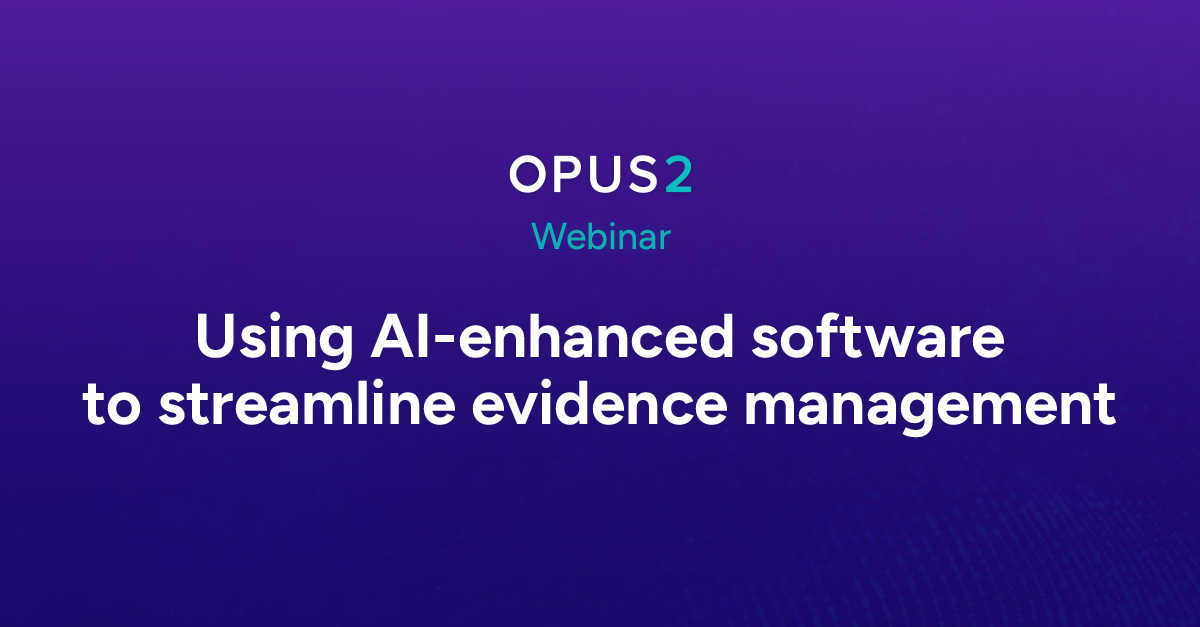Over the years, eDiscovery and case management have become increasingly intertwined, playing an essential role in ensuring successful litigation outcomes. As data volumes and caseloads grow, understanding how to effectively connect these two processes can streamline the entire case lifecycle and empower litigation teams to remain competitive in an ever-changing legal market.
Navigating the data overload
The sheer volume of data gathered during eDiscovery is staggering. Recent research from Ari Kaplan Advisors reveals that 93 percent of litigation teams are facing a noticeable increase in the amount of data involved in an average case. And 60 percent agree that continued growth will present challenges.
As litigation teams strive to identify critical documents during eDiscovery—the goal is not merely to identify responsive information but to pinpoint the facts that will drive the case forward. Even in instances where a case does not proceed to trial, organizing and analyzing this information plays a significant role in effective settlement negotiations and can increase the chances of successful dispositive motions practice.
The paradox of data growth
While data volumes in eDiscovery continue to grow exponentially, an interesting paradox emerges: the number of truly critical documents for trial or key decision-making has remained more or less the same. During a recent ILTACON session on connecting eDiscovery and case management, Rachelle Rennegal, Special Counsel at Pillsbury noted, “No matter how big your case is, it could be a case with 10,000 documents or a case with 2 million documents, what you end up maybe using … is probably going to be between 500 to 1,000 documents.”
Rennegal went on to say, “We’re drowning in information, but we have very little knowledge.” A sentiment that perfectly highlights a crucial challenge in modern litigation: how to efficiently sift through massive datasets to identify the small subset of truly impactful documents.
Adapting to the data landscape
As teams prepare cases and navigate this complex data environment, they can make adjustments that will help. By adapting to these challenges, legal teams can turn the data deluge from a burden into a strategic advantage, uncovering crucial insights that drive case strategy and outcomes.
- Embrace advanced case management: Use leading legal case management software to quickly identify patterns, relationships, and key documents within large datasets.
- Develop scalable workflows: Create processes that can handle varying data volumes without sacrificing efficiency or effectiveness.
- Foster data literacy: Ensure team members are trained to understand and interpret complex data analyses, turning information into actionable insights.
- Leverage AI and machine learning: Implement AI-analysis tools to automate initial document review, build a characters list, and create your case chronology, and more, allowing human experts to focus on high-value analysis.
The blurring lines between eDiscovery and case management
Historically, eDiscovery and case management have been seen as distinct processes. First, eDiscovery excels at document review and production workflows, providing the necessary tools for lawyers to efficiently respond to requests for production of documents. And in the next step when case management begins, the litigation team gets to work using the documents produced in eDiscovery to build their case strategies and begin preparing trial. However, the lines between these two areas are beginning to blur, creating a more holistic approach.
The continuum of litigation management
Rather than viewing eDiscovery and case management as separate entities, forward-thinking legal professionals are beginning to see them as part of a continuum, integrating practices and platforms to ensure a streamlined approach to litigation management.
- Early-stage integration: Case management now begins much earlier, often during the investigative discovery phase. This early integration helps in deciding whether a case will rise to the point of action and shapes the initial case strategy.
- Unified data approach: Information gathered during eDiscovery directly feeds into case management systems, creating a seamless flow of data from initial collection to trial preparation.
- Dynamic strategy development: The insights gained from eDiscovery inform and continuously refine case management strategies, allowing for more agile and responsive legal approaches.
- Collaborative workflows: Integrated systems foster better collaboration between eDiscovery specialists, paralegals, and attorneys, ensuring that all team members are working with the same, up-to-date information.
- Comprehensive case visualization: Modern tools allow legal teams to visualize the entire litigation lifecycle in dashboards and reports, from initial data collection to final disposition, providing a clearer picture of case progress and potential outcomes.
Practical applications of integrating eDiscovery and case management
When aligned, eDiscovery and case management can work together to deliver successful outcomes. This integration manifests in several practical ways:
- Connected platforms: Leading eDiscovery and case management solutions have robust integration capabilities, allowing for seamless transitions between data analysis and case strategy development.
- Automated chronology building: Advanced systems can automatically generate case chronologies based on eDiscovery data, saving time and reducing the risk of human error.
- Intelligent deposition preparation: Integrated systems can pull relevant documents and data points for specific witnesses, streamlining the deposition preparation process including deposition designations.
- Real-time strategy adjustment: As new documents or insights emerge from ongoing eDiscovery efforts, case management strategies can be adjusted in real-time, ensuring that the legal team is always working with the most current and relevant information.
By embracing this integrated approach, legal teams can work more efficiently, respond more quickly to new developments, and ultimately provide better outcomes for their clients.
Increasing the visibility and value of litigation support skills
As eDiscovery and case management come into close alignment, opportunities for advancement often arise. Because of the growing emphasis on the collaborative nature of case management, mindsets are shifting. Responsibilities are increasingly given to the person who is best suited for specific tasks rather than adhering strictly to job titles. This shift enables teams to be more agile, leveraging the strengths of their members to enhance overall case strategy. Litigation support professionals are well positioned to take advantage of this shift to enhance their skillset and increase their visibility while developing collaborative relationships with firm leadership.
Moreover, as litigation support professionals transition into leadership roles, they are increasingly taking on responsibilities related to innovation and knowledge management. This evolution reflects the importance and value of the skills developed in eDiscovery and case management, making these professionals highly sought after in today’s legal environment.
The transformative power of AI
Artificial intelligence (AI) is revolutionizing both eDiscovery and case management, offering new opportunities to enhance the litigation lifecycle. AI can automate repetitive and low-value tasks, such as document review, enabling legal teams to focus on high-value client work. For instance, AI-assisted case management solutions can review hot docs to quickly identify key characters and events, reducing the time required to create a case chronology.
However, it’s crucial to recognize that AI should be integrated thoughtfully into legal workflows. While AI has tremendous potential, human guidance remains essential. Legal professionals must find intuitive ways to incorporate AI into their processes, ensuring that they maintain oversight and leverage the technology to enhance their work rather than replace it. Leading case management solutions incorporate AI directly into existing workflows, use secure large language models to protect client data, and offer transparent citations for AI outputs. According to the recent litigation support research from Ari Kaplan, 87 percent of litigation support leaders believe that AI-assisted case management software is a competitive advantage.
The future of eDiscovery and case management
As the legal industry continues to grapple with ever-increasing data volumes, the alignment of eDiscovery and case management becomes not just beneficial but essential. By embracing new technologies, developing comprehensive strategies, and maintaining a focus on high-value work, legal professionals can transform raw data into decisive legal action.
Connecting eDiscovery and case management allows law firms to enhance efficiency, improve outcomes, and serve their clients more effectively in a rapidly changing landscape. Those who successfully navigate this integration will be better positioned to handle complex litigation, make data-driven decisions, and ultimately provide more value to their clients in an increasingly competitive legal market.








